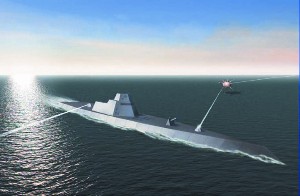Fleet Defense Eyes Lasers
 |
The U.S. Navy's free electron laser soon may be providing fleet air defense for surface vessels. Recent experiments have drawn scientists closer to power levels that will make the multifaceted defensive system a reality. |
The U.S. Navy has achieved milestone developments in free electron laser technology that may lead the way to shipboard lasers defending fleets from attacking aircraft and cruise missiles. Recent demonstrations have generated 1-kilowatt low-frequency beams, and scientists are on the brink of attaining 10-kilowatt laser beams.
Several engineering and physics challenges remain, but researchers now believe the way is clear for the gradual evolution of free electron lasers capable of generating beams as powerful as a megawatt. This would permit shipborne devices to defend fleets against proliferating enemy systems that threaten to overwhelm current surface ship defenses.
“The free electron laser is a really wild animal,” declares Gil Y. Graff, program manager for advanced weapons technology programs in the Expeditionary Warfare Department’s Strike Division at the Office of Naval Research (ONR), Arlington, Virginia. “It is unlike any other kind of laser.”
The ONR’s free electron laser program aims to build on the larger initiative underway in the Navy to develop and deploy electric ships. Part of this effort involves moving large amounts of electricity to power electric weapons, one of which is electric-driven lasers.
Graff cites the need for better fleet defense against incoming sea-skimming and cruise missiles as a prime driver for shipboard laser defense. Current defenses usually feature missiles and Phalanx guns, but planners have recognized for some time that adversaries are working to develop and deploy antiship cruise missiles with new technologies that could penetrate missile- and gun-based defenses. These missiles now can fly at lower altitudes and higher speeds, and future iterations may add maneuverability and reduced signatures. Conventional defenses may be reaching limits in their ability to defend against these threats, and they would require considerable investment to keep up with the new attack technologies.
“For every evasive G [gravity force] that a threat might do while weaving its way toward a ship, the defense must incorporate three additional Gs,” Graff observes. “To do that, you must push up speeds, and that gets harder and harder.”
The Navy also is concerned about asymmetric threats such as multiple incoming devices. Graff explains that an adversary might seek to overwhelm shipboard defenses by flooding an area with multiple low-technology threats. In this type of attack, the danger is not in the sophistication of the threat but in the depletion of a defensive system’s magazine.
Also, a ship’s rules of engagement might not permit engaging a seaborne asymmetric threat such as a flotilla of small craft approaching a vessel. The small craft could be harmless private vessels or explosive-laden suicide bombs, but the U.S. ship would need to wait until intent was established before engaging the boats. A large number of them all converging on the larger ship could ensure that one of them gets close enough to penetrate the defenses. The free electron laser will permit a ship to dispatch large numbers of individual targets in a short period of time.
Lasers also offer the potential of a robust defensive system that would remain effective for some time. They could respond to a number of sophisticated missile threats incorporating numerous evolutionary upgrades, which would allow “some relief in the long development cycle of missile/countermissile,” Graff contends.
The recent development of lasers that can operate at shorter wavelengths such as the infrared has helped advance the free electron laser. Atmospheric absorption is considerably less than at many other wavelengths, but the laser technologies in these wavelengths are relatively immature, Graff maintains. Nascent technologies include the free electron laser as well as solid-state devices such as diode-based lasers.
Two of the advantages of the free electron laser are that it is electrically driven and has a broad operation band in terms of wavelength and tunability, Graff notes. It also is not restricted to narrow wavelengths. Because it lases in a vacuum, it has “profound potential” for very-high-power lasers.
Free electron lasers developed in the original Strategic Defense Initiative in the 1980s and early 1990s could generate only a few watts of power, Graff relates. The Department of Energy’s Thomas Jefferson Laboratory in Newport News, Virginia, developed specialty technologies that enabled a step up in power output. Now, free electron lasers are capable of generating a kilowatt of power, Graff reports. An ongoing three-year program is increasing that by a magnitude of power to 10 kilowatts, and this goal may be reached this month.
But even this is only an interim step up. Ultimately, the Navy wants to deploy a free electron laser that operates in the megawatt range. However, attaining this goal requires more than merely scaling up existing systems, Graff imparts.
ONR scientists know that they must advance the state of the art of the technology rather than just build a bigger system, he explains. “We are in a mode now of backing off from the free electron laser system to the major subsystems, and [we are] trying to push the subsystem technologies to the point where we are confident that they scale to what needs to give us a megawatt-class laser.” At that point, the ONR will build a scalable free electron laser.
This scalable laser will be built with an improved architecture that permits scalability to the ultimate goal. It initially will operate at 100 kilowatts using the optimum accelerator frequency. Then, as key component technologies improve, they will be swapped out to reach the performance goal. “We will basically have the common infrastructure to go to the megawatt-class free electron laser,” Graff warrants.
Alternative architectures exist for meeting each of the goals of the major subsystems, Graff says. This effort will be larger and national in nature beyond that of the Thomas Jefferson Laboratory. ONR is receiving support from the U.S. Defense Department’s High-Energy Laser Joint Technology Office, and it also is working closely with the Naval Sea Systems Command’s Navy Directed Energy Weapons Program Office (PMS-405), which has been given development responsibility for directed energy.
Among the characteristics of the free electron laser that differ from those of other lasers is that it does not have a conventional gain medium. Graff describes it as a hybrid of an electron accelerator and a laser. Generated electrons are accelerated to relativistic speeds, at which point they are wiggled in an electromagnetic field. This interaction causes the electrons to accelerate and generate light. Graff notes that the interaction of the electron beam with the electromagnetic beam causes electron bunching, which creates the coherence necessary for a laser beam. These electrons, accelerated in a vacuum, generate high-energy photons in the same vacuum. Accordingly, there is no gain medium that can heat up and distort. The photon characteristics, which are defined by the electromagnetic field and the shape of the wiggler-induced acceleration, effectively are electrically controlled. This enables a broad capability, Graff maintains.
With the physics in hand, several obstacles remain to attaining the goal. One is the need for high-power-capable optics to navigate the high-energy electron beams precisely. Significant advances have taken place at the Thomas Jefferson Laboratory, but more work remains to be done.
Another hurdle is the system’s injector, which generates the electrons and initially accelerates them. This subsystem needs considerable scale-up, Graff states. He says that one of the major tasks is to increase the electron current, but electrons do not like to be tightly bunched. The challenge is to maintain beam properties while scaling up to achieve higher currents.
The laser’s magnets must be ruggedized to work in a shipboard environment, Graff notes. Magnet performance must be maintained in a vibrating environment as well as over time, or the high-energy beams might become misaligned. Other ruggedization goals include the ultralow vacuum and the cryogenic component. These items’ ruggedization remains to be demonstrated, he says.
Scientists must overcome a mixture of both theoretical physics and engineering hurdles, Graff notes. Materials research and development is underway for the laser’s photo-injectors. Researchers also are experimenting with radio frequency cavity physics to study issues relating to large fields and high currents.
With the design approach at the Thomas Jefferson Laboratory, scientists have been able to demonstrate energy recovery. Graff describes this as a powerful tool for reducing radio frequency power requirements. This approach recovers the electrons generated by the electron beam after they have generated the laser photons. The process slows down these electrons and captures the energy put into them to accelerate them. That energy in turn can be recycled into the electromagnetic field to accelerate the next group of electrons that pass through. The result is a considerable decrease in the power required to accelerate the electrons.
Researchers also have achieved breakthroughs in optics that can handle high power, Graff reports. This success alleviates one of the program’s significant concerns, he notes.
Power consumption is not a big problem with the free electron laser. A much greater challenge is to exhaust the heat generated by the device, Graff offers. More than 90 percent of the power generated by the system must be vented—a problem similar to that encountered by the existing surface-ship SPY-1 radar. This issue is still in the “nascent” stage of examination, he says.
The deployable version of the free electron laser will be able to equip future aircraft carriers to provide area defense. It also can fit on the future guided missile cruiser, the CG-21, Graff offers. However, it currently does not appear to be retrofitable to existing platforms, most of which do not have the necessary electrical infrastructure. ONR experts have examined drawings to determine how the laser might fit into specific ships. The projected system is nominally the size of a Mark-45 gun mount, Graff reports, so it should be compatible with the future evolution of the DD-21 destroyer.



Comments